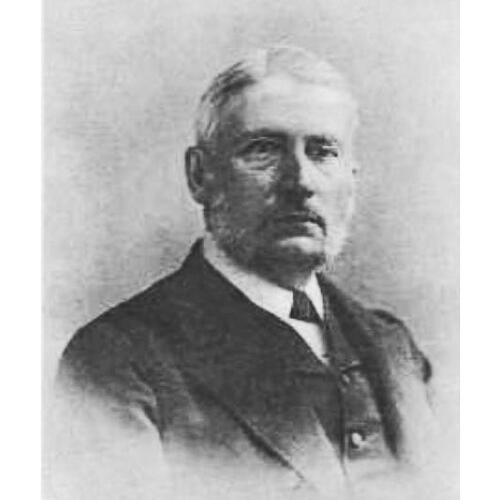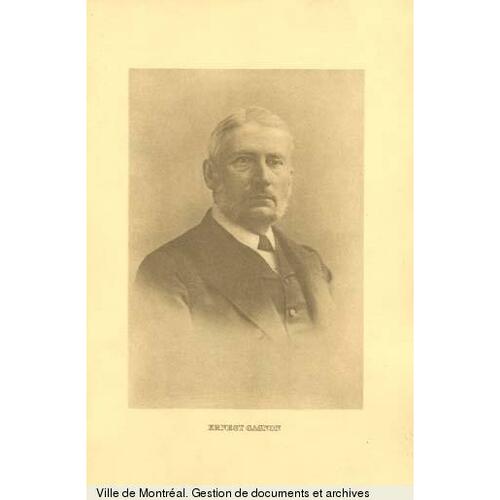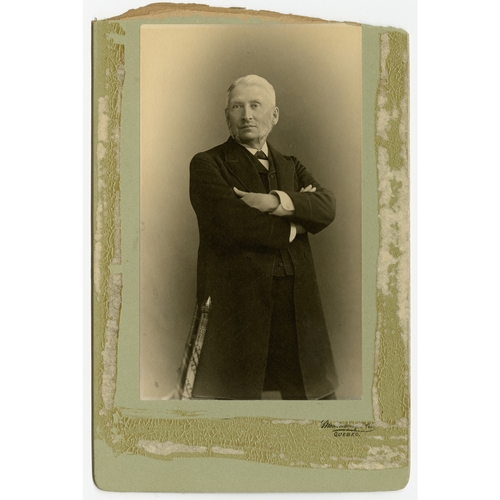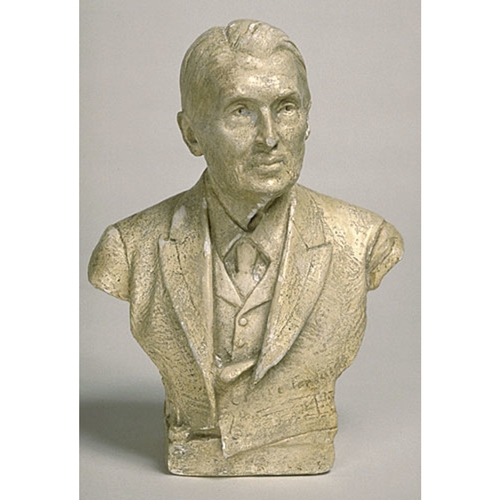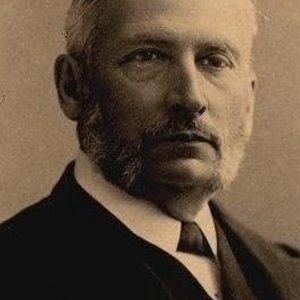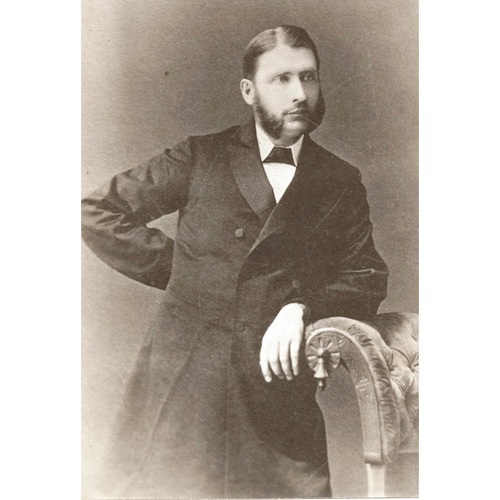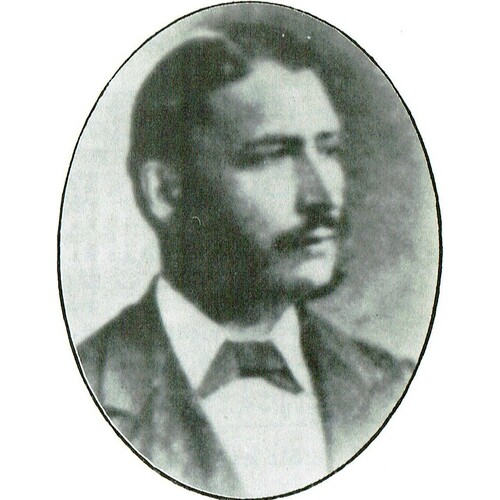
Source: Courtesy of Wikimedia Commons
GAGNON, ERNEST (baptized Frédéric-Ernest-Amédée), musician, teacher, composer, office holder, and author; b. 7 Nov. 1834 in Rivière-du-Loup (Louiseville), Lower Canada, fifth of the nine children of Charles-Édouard Gagnon, a notary, and Julie-Jeanne Durand; m. first 12 June 1860 Caroline Nault (d. 1871) in Quebec City, and they had two daughters; m. there secondly 7 Oct. 1874 Emma Cimon (d. 1919); d. there 15 Sept. 1915 and was buried in Notre-Dame de Belmont cemetery in Sainte-Foy, Que.
In the 1840s the Gagnon family was one of the first in the area of Trois-Rivières to own a piano. Young Ernest Gagnon was apparently fascinated by the instrument and he received some instruction from his elder sister Bernardine. At age 12 he entered the Collège Joliette, where he spent four years completing the classical studies program. In 1850 he moved to Montreal. There, he studied music with John G. Seebold and made the acquaintance of leading musicians, such as pianist and composer Charles Sabatier [Wugk*], who had emigrated to the Canadas from France, probably in 1848. Gagnon supported himself by working for different merchants in Montreal, one of whom was clockmaker and music merchant Louis Bilodeau. In 1853 Gagnon was appointed organist of Saint-Jean-Baptiste church in Quebec City, a considerable accomplishment for a musician of 19 years. Gagnon furthered his musical education on a yearlong visit to Europe in 1857–58, during which he studied piano at the Conservatoire de Paris with Alexandre-Édouard Goria and Henri Herz, and harmony and counterpoint with Auguste Durand. On this visit he met the famous opera composer Gioacchino Antonio Rossini. During this period Gagnon was introduced to the movement for the restoration of French plainchant begun by Benedictine Dom Prosper Guéranger and his disciples at Solesmes and to the method of plainchant harmonization of the French composer and theorist Louis Niedermeyer.
On his return to Quebec, Gagnon resumed his position at Saint-Jean-Baptiste and began careers as an organist, composer, pedagogue, and administrator. From the late 1850s through the 1870s his teaching duties were extensive and included responsibilities at the École Normale Laval, the Séminaire de Québec, and the Ursuline convent. He taught organ and classroom subjects such as ear training and choral singing. At the Ursulines’ school he also prepared the choir for the celebration of high feasts in the church year; he often assisted on such occasions, usually as organist. The generosity he showed the Ursulines throughout his life earned him a respected position within their community. At the time he was one of the few males permitted on the convent premises and the esteem in which he was held by the Ursulines is reflected in the title he held in local religious circles later in life, “the Ursulines’ pope.”
In the late 1850s and early 1860s Gagnon began composing music. Among his first compositions are three programmatic pieces: Stadaconé and Souvenir de Venise: grand nocturne pour piano for piano solo, and L’incantation de la jongleuse for violin and piano. Subtitled Danse sauvage pour piano, Stadaconé represents an attempt to incorporate particular characteristics of native music which he had gleaned from his contacts with native peoples in the area of Quebec City. These include descending melodic motives with the occasional large leap upward at the beginning of a phrase, reiteration of structural material, and the prevalence of an open fifth, which, like most non-natives, Gagnon interpreted as a drum-beat figure. Although marked by typical ethnocentric bias, his interest in native music was unusual for the time; it was also reflected in certain of his later writings, in particular a paper presented in 1906 and published the following year in Quebec as Les sauvages de l’Amérique et l’art musical. . . . Gagnon’s second composition for piano, Souvenir de Venise, was undoubtedly inspired by his visit to Italy and in some of its lyrical sections reflects the broadly flowing lines of Italian opera. Its musical style shows that Gagnon was acquainted with mid-19th-century trends in piano composition. The piece is an example of the salon music popular in Paris during the middle decades of the century; it is likely that Gagnon became familiar with this repertoire during his visit to Europe. An important aspect of L’incantation de la jongleuse is its program, which is derived from the legend of “La jongleuse,” published by Henri-Raymond Casgrain* in 1861. Gagnon does not use the legend’s narrative as a structural paradigm for his composition; instead he interprets the intriguing notion of the incantation or sounds of the jongleuse, which, in the legend, is a mysterious, magical force in the imaginations of the story’s characters. The form of the piece follows a structural plan of unfolding sections based on musical themes derived from the programmatic element. This organic conception of musical form is similar to that used by such 19th-century composers as Franz Liszt, who sought an extramusical idea as a creative point of departure.
In 1860 Gagnon gained public attention because of a quarrel with fellow musician Marie-Hippolyte-Antoine Dessane*, first over the Christmas carol Minuit, chrétiens (known in English as O holy night) by the French composer Adolphe-Charles Adam, and then over the question of plainchant harmonization. These debates took the form of a series of articles published in local newspapers. Both quarrels appear to have been provoked by Dessane, who was irked by Gagnon’s increasing prominence in music circles. Gagnon introduced Minuit, chrétiens to Quebec after hearing it for the first time in Paris at midnight mass in 1857 in Saint-Roch church, where his teacher Auguste Durand was organist. His initiative bothered Dessane who, as the Frenchman, felt a certain obligation to promote the music of his native country. Throughout the quarrels, public support remained with Gagnon who, in his own defence, always demonstrated genuine respect for Dessane and his point of view. The polemic over plainchant accompaniment, which followed soon after, arose from the publication of Pierre Lagacé’s Les chants d’église (Paris, 1860). Lagacé and Gagnon were both promoters in Quebec of the plainchant restoration movement under way in France and advocated the system of plainchant accompaniment described and illustrated by Niedermeyer. Dessane argued against the merit of Niedermeyer’s system both on principle (the intrinsic beauty of Gregorian chant is that it is unaccompanied) and on the grounds that Niedermeyer’s work had not gained acceptance in Paris. One interpretation of the Gagnon–Dessane polemic is that it illustrated the rivalry between the two most prominent French music schools of the day: the École Niedermeyer and the Conservatoire de Paris (from which Dessane had graduated). Again by his polite approach and rational arguments, Gagnon secured the public’s support. He and Dessane were among the best-known musicians living in Quebec City at the time and their contrasting backgrounds and personalities undoubtedly fuelled their rivalry.
Dessane’s confrontational attitude in the polemics and the public support for Gagnon throughout may have led to Dessane’s resignation as organist at Notre-Dame cathedral and to his replacement by Gagnon in 1864. Gagnon’s appointment marked the beginning of along family hold on the post at the church (which later became a basilica). He held the position until 1876, when he was replaced by his brother Gustave*. In 1915 Gustave was succeeded by his son Henri*, who remained organist until his death in 1961. Led by Ernest, the Gagnons were thus an important force in the musical life of Quebec City. Further evidence is the major role played by both Ernest and Gustave in the formation and early decades of the Union Musicale de Québec and the Académie de Musique de Québec, established in 1866 and 1868 respectively.
In 1873 Gagnon made a second trip to Europe as correspondent for Le Courrier du Canada (Québec). Accompanied by his colleague and friend Lagacé, he visited England, France, Italy, Austria, Bavaria, Luxembourg, and Belgium over five months. The articles he wrote for Le Courrier took the form of a series of letters which were later published as Lettres de voyage . . . (Québec, 1876). Highlights of this trip were a meeting at Solesmes with Dom Guéranger and an audience with Pope Pius IX in Rome. In Paris en route home Gagnon met fellow Canadians Calixa Lavallée* and Guillaume Couture, who were studying there.
The year 1875 marked a turning-point in Gagnon’s professional life. Relinquishing his teaching responsibilities, he became a public servant with the government of Quebec. He worked that year as secretary to Premier Charles Boucher de Boucherville and for an extended period, 1876–1905, as secretary to various ministers of public works. Gagnon evidently changed the direction of his professional career of his own volition. The high profile he had established as a musician in Quebec, as well as his participation in the administration of nationalist organizations such as the Institut Canadien and the Société de Colonisation de Québec, may have helped his candidature for these government positions. Gagnon also had some direct experience in politics, obtained when he had served as a municipal councillor in 1871–72. During his 30 years as a civil servant Gagnon continued to be involved in musical activities, playing, composing, and performing administrative work. This period also saw him focus on such historical projects as the biographies of 17th-century Canadian explorer Louis Jolliet* and a governor of New France in that century, Louis d’Ailleboust* de Coulonge et d’Argentenay. Both are well documented and vibrantly display the author’s scholarship. The seventh chapter of Louis Jolliet . . . (Québec, 1902) is a description of 17th-century musical life in Quebec. Basing his research on the Jesuits’ Relations, Gagnon describes the important roles played in that musical life by Bishop François de Laval*, priest and musician Charles-Amador Martin*, and Jolliet. The explorer was probably the first Canadian to study music in Europe and he was organist at Notre-Dame cathedral some 200 years before Gagnon.
Gagnon is perhaps best remembered for his collection of folk-songs, Chansons populaires du Canada, published serially in Le Foyer canadien (Québec) from 1865 to 1867, and in 1880 in a second edition, which was reprinted at least 13 times by the 1950s. Chansons populaires contains complete renditions (text and music) of just over 100 songs. This repertory includes some songs which Gagnon notated in the field and others which he added because of their pervasiveness in the song tradition of the day. He also provides commentaries for each song in which he discusses particular points concerning origin, variants, and musical characteristics. In the concluding essay, “Remarques générales,” he expands on this discussion with particular emphasis on the hypothesis of a link between the modality in the song melodies and that of plainchant. Although this argument did not have lasting support, it has historical importance as an early attempt to develop an analytical basis for examining a folk repertory; within a paradigm deriving from particular notions of the French Canadian “race,” Gagnon’s interpretation may be viewed as part of the burgeoning movement of nationalism in Quebec in the 1860s. Chansons populaires anticipated later developments in folk-song scholarship, particularly in terms of transcription and the interpretation of different rhythmic types. In its historical context the collection was part of the drive to affirm the notion of a French Canadian identity by uncovering the past – for Gagnon, as for many French Canadians, folk-song was an integral and unique aspect of that past.
Extending beyond collecting, Gagnon’s interest in folk music included making arrangements of popular songs – such as Un soir à bord (1859) and Le carnaval de Québec (1862) for piano solo and Les soirées de Québec (1887) and Chants canadiens (1882) for choir – and composing various settings for well-known songs on sacred themes. The arrangements of Cantiques populaires pour la fête de Noël, in particular, are still sung in Quebec. Later in life Gagnon also composed church music consisting of plainchant harmonizations and some original pieces. Intended by Gagnon for practical use and as an attempt to reform what he believed to be a corrupt state of church music in some parishes, his Accompagnement d’orgue des chants liturgiques . . . (Québec, 1903) is a large compendium of plainchant harmonizations. This volume reflects Gagnon’s lifelong preoccupation with the 19th-century movement for the restoration of plainchant, as well as his own adaptation of the system of harmonization developed by Niedermeyer in the 1850s. Like Niedermeyer, Gagnon believed that by creating appropriate organ accompaniments and assuring their tasteful performance, he was enhancing the spirit of the plainchant melodies.
Evidence of the high esteem in which Gagnon was held in Quebec is found in the crucial role he played as chair of the music committee for the Saint-Jean-Baptiste day celebrations in 1880, which resulted in the composition of O Canada, with music by Lavallée and words by Adolphe-Basile Routhier. Later in life Gagnon was recognized for his accomplishments when he was made a member of the Royal Society of Canada in 1902 and awarded a doctorat ès lettres from the Université Laval the following year; he had been a corresponding member of the Societe des Compositeurs de Paris since 1868 and was an officier de l’Instruction publique of France. Gagnon’s reputation as a musician and man of letters brought him into contact with distinguished Canadians and Europeans. He corresponded with French musicians and folk-song scholars Jean-Baptiste Weckerlin and Julien Tiersot (he met Tiersot on several occasions). In retirement from 1905, he included in his circle of friends sculptor Louis-Philippe Hébert, painter Charles Huot*, journalist Jules-Paul Tardivel*, judge Routhier, and historian Thomas Chapais*. In 1911 Gagnon met young folklorist Marius Barbeau*, a meeting which symbolized the link between two generations of folk-song scholars. Gagnon profited from his retirement years and worked at such projects as articles for the Revue canadienne (Montréal) until just before he died in 1915.
Gagnon was part of the literary and historical nationalist movement which emerged in Quebec in the decades after the rebellions of 1837–38. His deep-rooted faith in the Roman Catholic Church as well as a strong sense of nationalism emerge prominently as forces in his life and work. Those forces were fundamental tenets in French Canadian ideology and they stimulated all Gagnon’s intellectual and musical achievement.
[Following Ernest Gagnon’s death, his daughter Blanche was the first to research her father’s work. She edited his writings and was responsible for the publication of Pages choisies (Quebec, 1917), which includes a “Notice biographique” by Thomas Chapais, and Nouvelles pages choisies (Quebec, 1925). Her memoirs, Réminiscences et actualités (Québec, 1939), contain useful biographical details concerning her father.
A complete listing of Gagnon’s literary and historical writings is found in Roger Bonin, “Bibliographie de monsieur Ernest Gagnon” (mémoire, école de bibliothécaires, univ. de Montréal, 1945). A comprehensive inventory of Gagnon’s musical compositions, including his plainchant harmonizations and folk-song arrangements, appears in app.1 of the author’s dissertation, “Ernest Gagnon (1834–1915): musician and pioneer folksong scholar” (phd thesis, Univ. of Toronto, 1989); the first chapter of this work provides a detailed and fully documented biography of the subject. A listing of Gagnon’s literary and musical works also appears in the entry in the Encyclopedia of music in Canada (Kallmann et al.) prepared by the author and François Brassard. A number of Gagnon’s compositions have been published in vols.1–2 of The Canadian musical heritage, ed. Elaine Keillor et al. (15v. in 18 to date, Ottawa, 1983– ). Critiques of several of his writings appear in DOLQ, vols.1–2. Information on Gagnon is available in numerous biographical reference works of his period and later. Two other studies are worth noting: Conrad Laforte, La chanson folklorique et les écrivains du XIXé siècle (en France et au Québec) (Montreal, 1973), and Arthur Letondal, “Ernest Gagnon, écrivain et folkloriste (1834–1915),” Qui? (Montréal), 2 (1950–51): 65–80. g.e.s.]. ANQ-Q, CE1-1, 12 juin 1860, 7 oct. 1874.
Cite This Article
Gordon E. Smith, “GAGNON, ERNEST (baptized Frédéric-Ernest-Amédée),” in Dictionary of Canadian Biography, vol. 14, University of Toronto/Université Laval, 2003–, accessed November 20, 2024, https://www.biographi.ca/en/bio/gagnon_ernest_14E.html.
The citation above shows the format for footnotes and endnotes according to the Chicago manual of style (16th edition). Information to be used in other citation formats:
| Permalink: | https://www.biographi.ca/en/bio/gagnon_ernest_14E.html |
| Author of Article: | Gordon E. Smith |
| Title of Article: | GAGNON, ERNEST (baptized Frédéric-Ernest-Amédée) |
| Publication Name: | Dictionary of Canadian Biography, vol. 14 |
| Publisher: | University of Toronto/Université Laval |
| Year of publication: | 1998 |
| Year of revision: | 1998 |
| Access Date: | November 20, 2024 |


